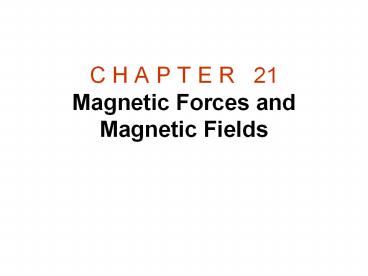C H A P T E R PowerPoint PPT Presentation
Title: C H A P T E R
1
C H A P T E R 21Magnetic Forces and Magnetic
Fields
2
Outline
- Magnets, Magnetic fields, and Magnetic field of
the Earth - Force on a moving charge in a magnetic field
- Motion of a charge particle in a magnetic field
- The mass spectrometer
- Force on a current in a magnetic field
- Magnetic fields produced by currents
- Magnetic Resonance Imaging (MRI)
- Cathode Ray Tube (CRT)
- Magnetic Tape recording and Maglev Trains
3
21.7. Magnetic Fields Produced by Currents
4
21.7. Magnetic Fields Produced by Currents
Right-Hand Rule No. 2. Curl the fingers of the
right hand into the shape of a half-circle. Point
the thumb in the direction of the conventional
current I, and the tips of the fingers will point
in the direction of the magnetic field B.
5
A LONG, STRAIGHT WIRE
6
Two Current-Carrying Wires Exert Magnetic Forces
on One Another
7
SOLENOID
8
Magnetic Resonance Imaging (MRI)
9
Cathode Ray Tube (CRT)
10
21.9. Magnetic Materials
Most substances are nonmagnetic, the magnetism
produced at the atomic level tends to cancel out.
However, there are some materials, known as
ferromagnetic materials, in which the
cancellation does not occur for groups of
approximately 1016 1019 neighboring atoms,
because they have electron spins that are
naturally aligned parallel to each other. This
alignment results from a special type of quantum
mechanical interaction between the spins. The
result of the interaction is a small but highly
magnetized region of about 0.01 to 0.1 mm in
size, depending on the nature of the material
this region is called a magnetic domain. Each
domain behaves as a small magnet with its own
north and south poles. Common ferromagnetic
materials are iron, nickel, cobalt, chromium
dioxide, and alnico (an aluminum-nickel-cobalt
alloy).
11
INDUCED MAGNETISM
12
Magnetic Grippers
13
MAGNETIC TAPE RECORDING
14
MAGLEV TRAINmagnetically levitated train
PowerShow.com is a leading presentation sharing website. It has millions of presentations already uploaded and available with 1,000s more being uploaded by its users every day. Whatever your area of interest, here you’ll be able to find and view presentations you’ll love and possibly download. And, best of all, it is completely free and easy to use.
You might even have a presentation you’d like to share with others. If so, just upload it to PowerShow.com. We’ll convert it to an HTML5 slideshow that includes all the media types you’ve already added: audio, video, music, pictures, animations and transition effects. Then you can share it with your target audience as well as PowerShow.com’s millions of monthly visitors. And, again, it’s all free.
About the Developers
PowerShow.com is brought to you by CrystalGraphics, the award-winning developer and market-leading publisher of rich-media enhancement products for presentations. Our product offerings include millions of PowerPoint templates, diagrams, animated 3D characters and more.

